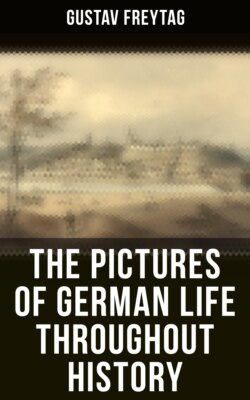The Pictures of German Life Throughout History

Реклама. ООО «ЛитРес», ИНН: 7719571260.
Оглавление
Gustav Freytag. The Pictures of German Life Throughout History
The Pictures of German Life Throughout History
Table of Contents
Volume 1
Table of Contents
INTRODUCTION
CHAPTER I. SCENES FROM THE HUSSITE WAR
(about 1425.)
CHAPTER II. A GERMAN LADY OF THE ROYAL COURT
(about 1440.)
CHAPTER III. THE TRAVELLING STUDENT
(1509, and following years.)
CHAPTER IV. THE MENTAL STRUGGLES OF A YOUTH, AND HIS. ENTRANCE INTO A MONASTERY
(1510.)
CHAPTER V. OUT OF THE MONASTERY INTO THE CONFLICT
(about 1522.)
CHAPTER VI. DR. LUTHER
(1517–1546.)
CHAPTER VII. GERMAN PRINCES AT THE IMPERIAL DIET
(1547.)
CHAPTER VIII. A BURGHER FAMILY
(1488–1542.)
CHAPTER IX. THE MARRIAGE AND HOUSEKEEPING OF A. YOUNG STUDENT
(1557.)
CHAPTER X. OF A PATRICIAN HOUSE
(1526–1598.)
CHAPTER XI. GERMAN NOBILITY IN THE SIXTEENTH CENTURY
CHAPTER XII. THE GERMAN IDEAS OF THE DEVIL IN THE. SIXTEENTH CENTURY
FOOTNOTES:
Volume 2
Table of Contents
INTRODUCTION TO THE SECOND VOLUME
CHAPTER I. THE THIRTY YEARS' WAR.--THE ARMY
CHAPTER II. THE THIRTY YEARS' WAR.--LIFE AND MANNERS. OF THE SOLDIERS
CHAPTER III. THE THIRTY YEARS' WAR.--THE VILLAGES AND. THEIR PASTORS
CHAPTER IV. THE THIRTY YEARS' WAR.--THE CLIPPERS OF MONEY, AND PUBLIC OPINION
CHAPTER V. THE THIRTY YEARS' WAR.--THE CITIES
CHAPTER VI. THE THIRTY YEARS' WAR.--THE PEACE
CHAPTER VII. ROGUES AND ADVENTURERS
CHAPTER VIII. ENGAGEMENT AND MARRIAGE AT COURT
(1661.)
CHAPTER IX. OF THE HOMES OF GERMAN CITIZENS
(1675–1681-1683.)
CHAPTER X. GERMAN LIFE AT THE BATHS IN THE SEVENTEENTH. CENTURY
CHAPTER XI. JESUITS AND JEWS
(about 1693.)
CHAPTER XII. THE WASUNGER WAR
(1747.)
CONCLUSION
FOOTNOTES:
Отрывок из книги
Gustav Freytag
15th, 16th and 17th Century
.....
It was among the thousands who, like the boy Thomas, thronged to the Latin schools, that the new movement won its most zealous followers. These children of the people carried from house to house with unwearied activity their new ideas and information. Many of them never arrived at the university; they endeavoured to support themselves by private tuition, or as correctors of the press. Most of the city, and in later times the village schools were occupied by those who could read Virgil, and understand the bitter humour of the Klagebriefes, de miseria plebenorum. So great were their numbers that the reformers soon urged them to learn, however late, some trade, in order to maintain themselves honestly. Many members of guilds in the German cities were qualified to furnish commentaries to the papal bulls, and translate them to their fellow-citizens; and subtle theological questions were eagerly discussed in the drinking-rooms. Great was the influence exercised by these men on the small circles around them. Some years afterwards they, together with the poor students of divinity who spread themselves as preachers over all Germany, became a great society; and it was these democrats of the new teaching who represented the Pope as antichrist in the popular plays, harangued the armed multitudes of insurgent peasants, and made war on the old Church in printed discourses, popular songs, and coarse dialogues.
In this way they made preparation for what was coming. But however clearly it had been shown by the Humanitarians that the Church had in many places falsified the Holy Scriptures, however humorously they had derided the tool of the Inquisition--the baptized Jew Pfefferkorn, with his pretty little wife--and however zealously the small school teachers had carried among the people the colloquies of Erasmus on fasting, &c., and his work on the education of children, yet it was not their new learning alone that gave birth to the Reformation and the spiritual freedom of Germany. Deeper lay the sources of this mighty stream; it sprang from the foundation of the German mind, and was brought to light by the secret longings of the heart, that it might, by the work of destruction and renovation, transform the life of the nation.
.....